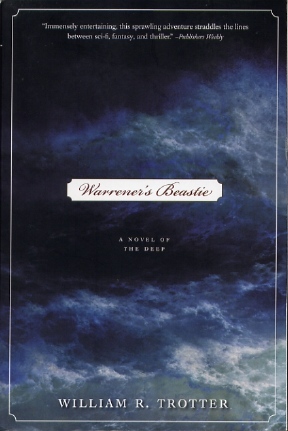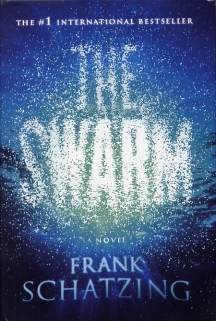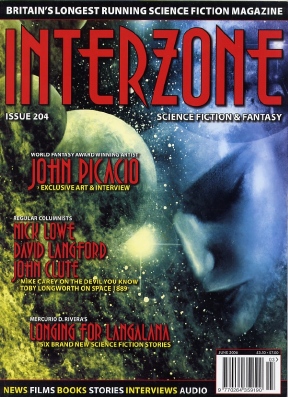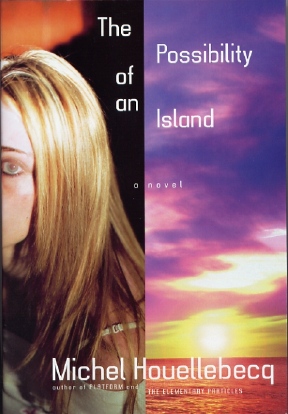|
|
|
This Just In...News from the Agony Column
|
06-23-06: William R. Trotter 'Warrener's Beastie' and Frank Schatzing's 'The Swarm' |
||||||
Dive
Into Big Blue Books About the Deep Blue Sea
'Warrener's Beastie' by William R. Trotter (Carroll & Graf / Avalon ; July 11, 2006 ; $17.95) and 'The Swarm' by Frank Schatzing (Regan Books / HarperCollins; May 23, 2006 ; $24.95) should fully satisfy your fat-book desires for the summer and then some. Plus, they both feature water monsters. How can you go wrong with a book about water monsters? Between June 29, 2001 and this fine day, I have collected 344 articles via the forteana lists about water monsters, featuring subjects as diverse as "Typhoon Globster" (China.org, July 21, 2005) to "White witch to tempt Nessie" (BBC, June 12, 2003). I love water monsters, whether they're lake-bound sea serpents or ocean-going giant jellyfish-like blobs that wind up on the beach and are deemed "globsters". (Usually, alas, these turn out to be rotting whale carcasses, but one can hope, can't one?) So when you get not one, but two big blue books on sea monsters, well, it's not hard to sign me up. I'm already on board. 'Warrener's Beastie' is certainly the most unusual of the two. Trotter is best known for his Civil War fiction, including "The Civil War in North Carolina", a non-fiction trilogy that is cited as source material for 'Cold Mountain'. But I know him from the pages of DeathRealm magazine, where he was a regular for many years, and 'Warrener's Beastie' fits much more snugly into that oeuvre. That said, you may not find this one shelved with the horror, science fiction or fantasy titles. In Bookshop Santa Cruz, I found it tucked away high on a shelf with trade paperback fiction. (Thus the $17.95 price tag for a 686-page novel.) So if at first you don’t succeed in finding it, realize that you may have to look beyond the genre fiction titles. Likely, the confusion going on for booksellers is two-fold. First off, Trotter is known for the Civil War stuff. Secondly, the packaging here is rather classy for a genre fiction title. As much as you may want to think that this is a Les Edwards / Edward Miller painting, it proves to be a detail from "Wave" by Ivan Ayvazovsky from 1889. It certainly has a classy vibe that does not scream, "Lovecraftian sea-monster god". Unless you know going in that there's a Lovecraftian sea-monster god happening. Then of course, it's obvious. What's not obvious is that Trotter delivers a beautifully crafted novel on a number of levels. Part family saga, Norse-fantasy evocation and (of course, you can't hammer this one home too often) Lovecraftian sea-monster god, 'Warrener's Beastie' begins early in the lives of its main characters, following Allen Warrener from his childhood in Dickensian detail. Like Karen Hambly, he has mystical experiences, which, in not-so-short order, lead him on a cryptozoological expedition to find something known only as The Vardinoy Monster. And that's as much as you want to know. Monsters. Family. Details. Trotter's novel fires off as a character-and-detail-driven literary work, then it voyages into realms of fantasy, science fiction and horror. Did I mention the sea-monster? 686 pages, guaranteed monster, find it with literature. What could be more appropriate? This is the kind of novel I'm here for.
So when whales start attacking ships, maybe it's time to listen to these folks who say that the Navy's various radar experiments are pissing them off, no? But wait, there's more, a lot more, and I'm not giving away one whit. The point of immersing yourself in a book is to immerse yourself, and the point of this column is to help you connect with the books you miss that are worth reading in a variety of reading styles. So if you are looking for a nice, fat, 881-page monster/disaster-in-the-ocean novel, this is that novel. Enjoy the sights around the world as the world goes to hell. Don't read the DJ or the other copy. This is my favorite kind of literary world tour. Schatzing does not offer a lot of, er innovation. His science fiction twists are not going to drop any genre-reading jaws. But what he does offer is a lot. Now, I wouldn't want to read one of these types of books every day, but getting the two of these this summer is something of a treat. Schatzing's characters are given enough room to grow on you, and his maguffin is at least clever enough to give him room to elaborate. These are both roomy novels, the kind you move into for week or two. Trust me, you'll likely have to look about for them. They're not going to be stacked with lesser novels on the this-is-hot tables at the front of the stores. But should the phrase "Lovecraftian sea-monster god" (applicable to both books, sort of) be the kind of thing that puts a book on your must-buy list, then get aboard one or both of these books. We can't all live by the beach, but we can all read about how the lucky ones who get to get et up by any one of a variety of monsters. Though, if the truth is to be told, I live pretty close to the beach, and I'm hoping to avoid the getting et up part. One hopes that reading such books about Lovecraftian sea-monster gods will sort of inoculate one from actually encountering Lovecraftian sea-monster gods. If you don’t hear from me, I'm in the belly of a beast–or a book. |
|
06-22-06: Susanna Clarke Visits 'The Ladies of Grace Adieu' |
||||||
Comedic
Charm and Ageless Harm
With 'The Ladies of Grace Adieu and other Stories', readers can wrap their brains around Clarke's unique take on fantasy literature in a couple of hours as opposed to a couple of weeks. 'The Ladies of Grace Adieu and other Stories' collects seven stories previously published in not-so-much-of-a variety (I'll explain; hang on) of settings and one new story. All include illustrations which one would be inclined to presume are by Portia Rosenberg, who illustrated 'Jonathan Strange and Mr Norrell'. At this point however, the ARC I have tells me only that I can expect that on certain blank pages there is an "ILLUSTRATION TO FOLLOW". And here one is...
That said, the stories here all take place in versions of England that are similar but not necessarily precisely the same England within which 'Jonathan Strange and Mr Norrell' transpired. Some of the details may blur out a bit, and there may be strange off-ramps into versions of the story we read that don’t have onramps in the story we read. That said, the vibe is precisely the same. There's that delightful feel of stand-offish scholarship, emphasized by the "Introduction by Professor James Sutherland, , Director of Sidhe Studies, , University of Aberdeen". In it, the speaker suggests that the collection of stories is meant to throw some light on history of magic in the British Isles and to, "create a sort of primer to Faerie and faeries." Now let's be quick to remind readers that these are not nicey-nice faeries. They’re rather reminiscent of the sinister beings one encounters in Arthur Machen. Oh, there are moments of sweetness, but they’re matched by moments of darkness and danger; the velvet gloves conceal cold-steel stilettos. Clarke has a wonderful way of mixing the comedic and the strange, the gorgeous and the hazardous in an intimate and bewitching manner. Back in the day, we would have pegged this as a collection of horror stories, pure and simple, though it's neither pure nor simple. But if it helps you to get past an understandable (to me) leeriness when confronted with "faerie", then by all means call these horror stories. Because they rock and they are fun as hell to read. Readers who are simply thirsting for more Susanna Clarke-ness will become re-acquainted with characters familiar from the novel. There are stories involving the Duke of Wellington ("The Duke of Wellington Misplaces His Horse") and the Raven King (the new story, titled "John Uskglass and the Cumbrian Charcoal Burner"). You get Clarke's take on Mary Queen of Scots ("Antickes and Frets") and footnotes that bring on Thomas Jefferson ("Tom Brightwind or How the Fairy Bridge..."). What you don't get is more than 227 pages. Essentially, my take is that we're getting a bit of faerie essence while we wait for the next brick to arrive. The trick here is that now we must sort of, well, watch the skies, or at least, the Bloomsbury website and see if any special editions are in the offing. So far none is apparent, but be assured that when I know, you will. Yes, yes, we're here to share the friggin' magic, right? Sharing the friggin' magic: There may very well be a UK special edition. So stay tuned keep yer eyes peeled and don't put 'em on the shoulders of some guy wearing a big coat connected by tubes some some really weird stuff. |
|
06-21-06: Off the Rack |
|||||||||
A
Look at Interzone, New Genre, and Fortean Times
Right. Apparently, there's still some room left to evolve for those willing to change. Take for example, Interzone 204. When I first subscribed to Interzone, it had the content down to a science; you probably wouldn’t love every story in every issue, but there was enough quality to keep you reading and enough greatness to keep you happy. As Andy Cox took over, there was to my mind only one further step they could take, and with 204 they’ve done it: full, four color-printing. Mind you, this is a dangerous step, but I have to say that Cox & Co have brought the presentation up to equal the quality of the content. It certainly helps to have as their first subject genre-super-star John Picacio. Studded with his incredible art, a full-color Interzone could hardly go wrong. But with four-color-power goes fourfold responsibility. Once you cross the threshold of FFCP (full, four-color publication) a couple of great hazards present themselves. The first is that the designers of the magazine are now in a very different territory. When you have all those colors, all that potential, it's all too easy to turn a readable journal into a mind-splintering mess. We see this happen on the web all the time, with online publishers who seem to think that readers enjoy reading in a casino, with written content surrounded by flashing lights and scrolling adverts. For this reader, at least, this is an immediate turn off. Going to FFCP in print can enable a design staff to turn what was once readable into a printed casino; or it can liberate them. For the staff of Interzone, the evolution to FFCP has been a liberation. The stories are just as readable as they were before, in fact, to my mind more so. White print on dark colors is quite tolerable (as in Jamie Barras' Summer's End) when the final, sent-to-the-reader-end-product is this spectacularly produced. In fact it's beyond tolerable, it's every bit the equal to Barras' excellent fiction. The illustrations are nicely done and nicely used, with detail pull-outs extending the life beyond a single shot. FFCP also allows a tasteful publisher to make review sections more entertaining. Once again, hand it to Interzone. They've done an outstanding job at making all the review, news and commentary sections lovely to look at as they are to read. Even if a magazine manages to go to FFCP without creating the "reading in a casino" effect, there's another equally deadly trap. Horrific advertising. And once again, whether through lack of advert customers or deliberate choice, Interzone has done itself proud here. The adverts, for movies and books, are not so plentiful as to make finding the content difficult. Stories and article run from beginning to end sans interruption. And they aren't terribly embarrassing, either. Interzone 204 takes this venerable magazine to the absolute top echelon of genre publications. Science fiction gets what it deserves with Interzone 204.
By the time you get through the opening essays, you know to expect something special from the fiction, and it doesn't disappoint. 'Bink is Luv' by Jan Wildt demonstrates that even though New Genre confines itself to beautifully printed B&W literary stylings, there;s still room for visual flair. It's required in Wildt's oddball science fiction vision. Paul Gilster's science fiction is equally well-written, but comparatively calmer in content. Christopher Harman and Don Tumasonis offer literate, superb horror. If you care about genre, if you enjoy the horror and science fiction genres, if you think there's more to the genres than the latest mass-market paperback thrillers, then you want to find New Genre issue four immediately. Between these two poles -- the FFCP of Interzone 204 and the austere literary quality of New Genre issue four, you can see that periodical genre fiction is in fine shape.
I'm happy to report that this issue does not feature any reportage on science fiction media, (I like Doctor Who as much as anyone else, but don’t feel that it's the proper subject for FT) but keeps the focus on, well weird forteana, as it should. Yes, it does feature advertising that will make you cringe. But who can resist a cover like this? I sure as hell can't, and neither should you. With articles on penis-theft and Ogopogo, FT seems to be finding their way back to the fold. The interior design is somehow cleaner these days, a biut more scholarly and easy-to-read. I do wish they;d do something about the "Strange Days" features, which are after all, the meat-and-potatoes of Forteana. It's better, but I hold out hope that it can get better still. When you can slap down a magazine that looks like this, with content that includes "Death Worm Diaries" – the journal of an expedition into the Mongolian desert to find the Mongolian Death Worm – well, you're good for a whole month. And that is precisely the point of the periodical, is it not? |
|
06-20-06: John Shirley Digs 'Cellars' |
|||
What
Waits Below
'Cellars' gives readers the goods in spades, to be excavated with spades. From the hellish pits first explored by Lovecraft, Shirley unleashes your basic, under-the-city-monster. From the misrerable refuse, from the filth-encrusted urban garbage, our own emotions rot then rise up again in a stinking fug to envelop us in our own ugliness. Carl Lanyard is an occult investigator who comes at it armed with little more than quick wits, an ability to believe in the monster that's eating people right in front of his eyes, and a brace of verboten lore. But can he scotch the snake before it consumes those he loves as well as those he could give a good green shit about? Shirley surely isn’t digging into new ground here, and he wasn't doing so twenty years ago. Neither was Lovecraft back when he crafted "Cool Air," a tale designed to make readers afraid not of the dark and the dank and the lonely, but the light and the busy bits of a modern city. Horror writers have always sought to transform the most mundane places of our lives into sources of terror. But Shirley, like the best before him, had more in mind than simply scaring the bejeebers out of his readers. Shirley is not just excavating monsters to scare you, but rather essences to inform you. It's one thing to see a picture of a monster; it's another entirely to realize you’re looking in a mirror. Shirley's mirror is Uglytown, anywhere USA, but his haunts are the Lower East Side of New York City. As much as we like to think that we live in a monolithically first-world nation, that's not the case. Not only is the future not distributed evenly about the globe; the present is pretty spottily strewn about as well. And the environs that Shirley capture have more in common with Victorian London than squeaky clean Mallville, USA. As he demonstrated much later on in 'Wetbones', Shirley knows the scrungiest parts of this particular urban topography quite well. It's no stretch of the imagination for him to backfill these landscapes with supernatural and surreal creatures, monsters of the Id. 'Cellars' may be the most horrific novel of social justice you'll ever shiver through. That's why more than twenty years on, it can be republished with barely a blip of editing. That doesn't boil down to no updates, however. Shirley has edited the novel to reflect the twenty-plus years of writing he's done since, aiming for a leaner and meaner cut. He's added an epilogue that was originally deleted, but since he'd lost the original prose, he was forced to re-create it from scratch. Edward Lee provides the introduction, emphasizing three magic words: FLESH FOR SATAN. InfraPress is to be commended for their generous hardcover and trade paperback editions, though I've got to say the cover I'm looking at now could be improved. Sometimes, alas, one is forced to fall back on the old "don’t judge a book by its cover" routine. But where is J. K. Potter when you need him? There are some scenes in here that cry for his un-tender mercies. Such are life and death; patently unfair. But then it seems unfair that most of Shirley's audience for this novel probably was not even born when it was first printed. On the other hand, it's a testament to the novel itself that this is the case. We'll always need our monsters, and we'll always look for them in the timeless shitholes of the city. And in well-written horror novels. |
|
06-19-06: Michel Houellebecq Foresees 'The Possibility of An Island'; A 2006 Conversation With David Sirota |
|||
The Future of Laughter
Just one. Michel Houellebecq is at it again. Not content with excavating Lovecraft from the tomb of adulation and understanding within which he had been interred in the side-splittingly funny 'H. P. Lovecraft: Against the World, Against Life', Houellebecq is out to make eyeballs pop and ears steam. His new novel, 'The Possibility of an Island' is guaran-fucking-teed to piss off everyone who is not laughing their asses off. All this in the opening passages. All this in a work of pontificating, philosophical, very, very French science fiction. Oh, you'll just hate this book. Unless, of course, it gets you in stitches. And from the get-go, it has me in stitches. Uncomfortable, "I shouldn’t be laughing at this," stitches, but still. Houellebecq is an original, you've got to give him that. Of course, for a certain large portion of the audience, he might be the kind of original that makes you want to toss the book right across the room. Make no mistake about it, I like this book. So long as I am the editor, I have the pleasing option of assigning myself only books that I do like, and given how long I've been reading and how much effort I put into reading, you can damn well bet that I've gotten pretty good at finding books I like. But as much as I like this book I can't help but realize that it's the kind of book that might alienate a large portion of the American science fiction reading public. So let me try to see if I can give you an idea of whether this is the sort of book you love to read or the sort of book you'll love to hate. The science fiction setup here is pretty simplistic; this is not an overly cerebral bit of hard SF. Daniel is a man not unlike the author, a writer who has made a career out of annoying and entertaining his audience. The story unfolds as both the original Daniel ("Daniel 1") and his subsequent clones tell their stories from a future without any pesky, sweaty humans to clutter the beautiful landscape. These stories pretty much encompass, life, women, the family and everything. And not in a good way. Daniel, you see, has rather a bad attitude. As does Houellebecq. 'The Possibility of an Island' is a novel that is likely to lose most female American readers before it even really begins. Daniel's language is, not to put too fine a point on it, crude as fuck. Did I say fuck" in my column? Apparently, and in this particular article, it won't be the last time, I suspect. Houellebecq is out to offend, and as a critic, it's my duty to convey the sense of his work. On one hand, you’re going to encounter a fair amount of fairly dry philosophizing here. It strikes me as seeming very "French": "The self is the synthesis of our failures; but only a partial synthesis. Fear what I say. "This book is intended for the edification of the Future Ones. Men, they will tell themselves, were able to produce this. It is not nothing; it is not everything; we are dealing with an intermediary production. "Marie22, if she exists, is a woman to the same extent that I am a man; to a limited, refutable extent. "I too am approaching the end of my journey. "No one will be present at the birth of the Spirit, except for the Future Ones; but the Future Ones are not beings, in our sense of the word. Fear what I say." Okey-dokey, I'm a-feared, all right. Well, after the silly grin. I mean, you can't take this crap seriously. And you're not meant to, but you are meant to. This is High-Effin'-Art on laughing gas. These are the words of a man who has achieved a sort of black hole of egoism. His personality is a singularity into which universes of understanding and normal science fiction have been sucked. And these words are as funny as hell, unless of course Houellebecq is tearing your heart out, only to devour it laughing, right in front of your eyes. Houellebecq keeps things pretty zippy here, between the stories of Daniel 1 joining the Very Healthy Ones and his clones trying to figure out if they're even real anymore, or just subroutines running on something. If the clones are just virtual, then whatever it is that they're running on is something that's Not Real Friendly so far as humankind is concerned. What Houellebecq is doing in 'The Possibility of An Island' and quite successfully to my mind, is using science fiction tropes, ideas and styles to evoke outrage and dislocation, to make readers who can take it laugh and mostly just to mindfuck the living shit out of readers' tiny brains. There's certainly an "if you can take it" factor at work here, and those accustomed to say, calming sorts of stories with characters we like, or at least don't want to run over repeatedly with our cars until they are jellied, quivering masses, well, those readers are gently guided over to something more normal. More American. But there's a lot to be gained from doing the Polar Bear Club thing and diving into this cold and bracing water. As a reading experience, 'The Possibility of An Island' has no equivalent. Houellebecq does things with his story, with his words that you just can't do in normal fiction. Transgressive is far too passive a term to describe this writing. I suspect that readers who admire Chuck Palahniuk's more outré explorations might be able to embrace this novel. Well, maybe embrace is too strong a word. Embracing 'The Possibility of an Island' is like hugging a porcupine. Oh, you may love those little critters, and find them just adorable. But generally, not huggable. So, thinking again, maybe nobody should embrace 'The Possibility of an Island'. But if you're up for an equal-opportunity offender, then hug away. Those needles won’t hurt you. They won’t burrow into your flesh and slowly rot, infecting your bodily fluids. That's not sickness or contagion at work. It's just bad, bad, attitude you've got there. No cure for a bad attitude. Well, one maybe. |
|||
Fighting the 'Hostile Takeover'
'Hostile Takeover: How Big Money & Corruption Conquered Our Government–And How We Can Take It Back' is a pretty damn compelling page turner for something that the author sees, as he told me when we talked, as something of a handbook. When the politicians of both parties start lying to us, 'Hostile Takeover' is a great way to check up and see what exactly lies behind the lies we're being told. But rather than follow a blow-by-blow recap of what was in the book, I managed to pull out a few recurring, overarching themes that I found most fascinating. To me, the top of the list is what Sirota calls "the race to the bottom". This seems to me to be the most pertinent aspect of what's happening around us right now, and I think that listeners will find his explanation bracing. OK, acid rain bracing, but still. It's nice that Sirota is on to corruption on both sides of the aisle, but also that he identifies the heroes as well as the hacks. He sees a lot of hope, unlike many out there. For just about anyone of any political stripe, Sitora's interview is a eye-opener. But more than that, he just seems reasonable, more of a researcher than a pundit. Readers should definitely take a look at his poklitical blog at DavidSirota.com. So the usual tricks apply here; you've got the RealAudio and the MP3 versions. Sirota will, in the end of this interview give anyone who wants to see things change, who wants to participate, some pretty damn useful advice. However you manage to get into the fray, Sirota will at the very least keep you well focused on his words. As Kim Stanley Robinson says -- in what to my mind is likely to be the epitaph for the 21st century: "We're living in a bad science fiction novel." Lets edit! |









